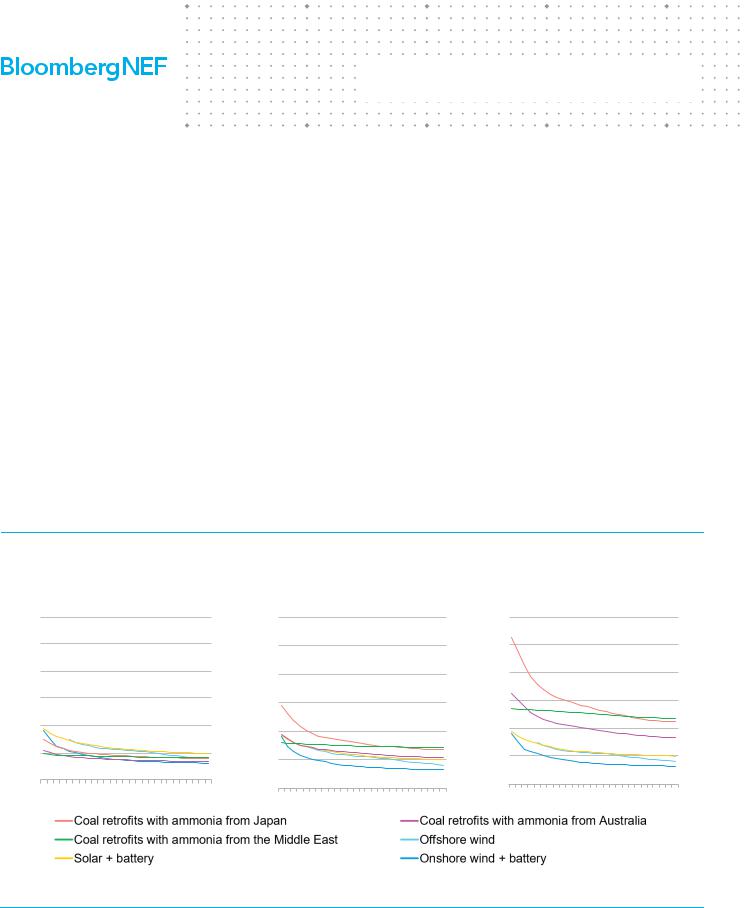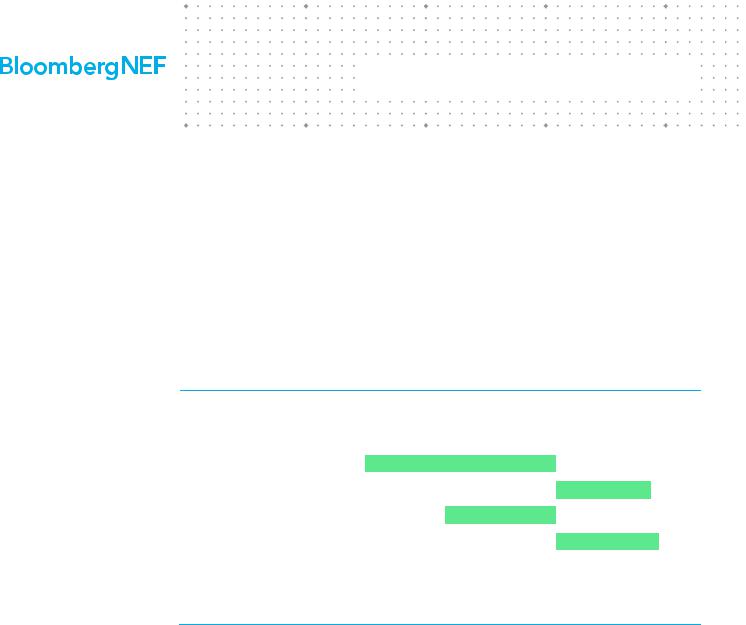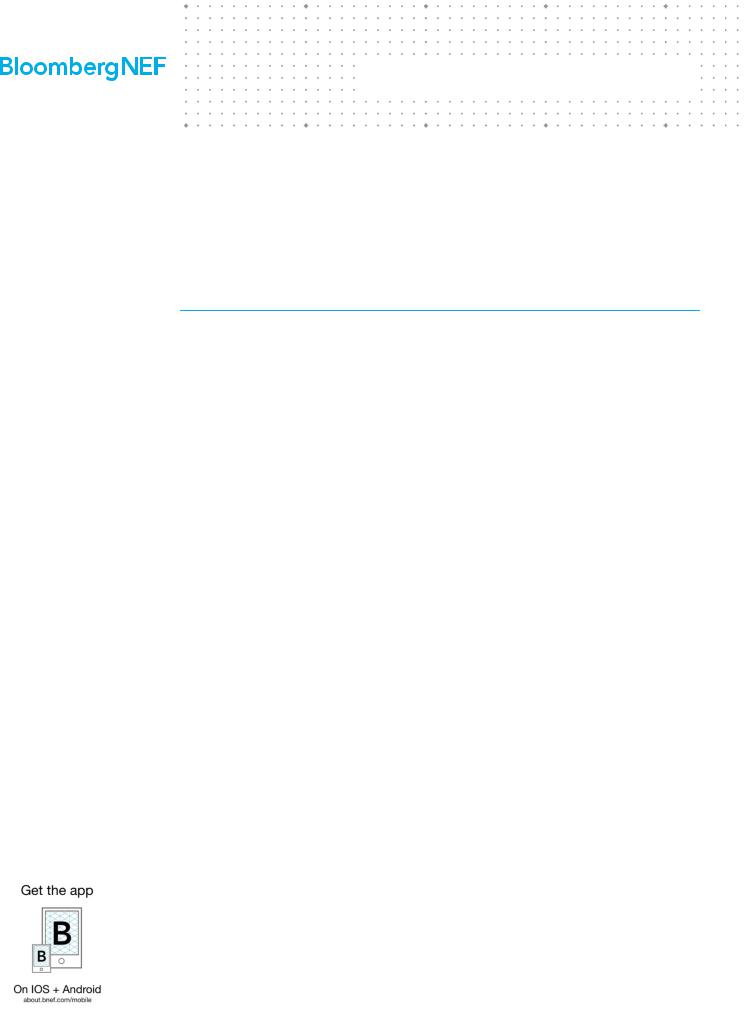
01 POWER ISLAND / 02 H2+NH3 / (BNEF) 2022 Japans-Costly-Ammonia-Coal-Co-Firing-Strategy
.pdf
Japan’s Costly Ammonia Coal Co-Firing Strategy
September 28, 2022
Consequently, Japan’s energy security may worsen by switching from coal imports to coal and ammonia imports. By relying on two imported commodities to operate coal-fired power plants, rather than one, Japan runs the risk of worsening its long-term energy security.
7.4.Clean ammonia’s role in decarbonization
To identify whether clean ammonia can play a role in decarbonization of a particular sector, we need to consider four factors:
1.Are the technologies for ammonia usage in that application already mature?
2.What is the competitiveness of clean ammonia compared to fossil fuels used in that application?
3.How competitive is clean ammonia compared to other decarbonization approaches for that application?
4.How willing are customers for that application to pay for clean ammonia?
Table 5 summarizes these factors for clean ammonia usage in Japan.
Table 5: Suitability of ammonia for end uses in Japan
Use case |
Fertilizers |
Shipping |
Electricity generation |
Electricity generation |
|
|
|
(Seasonal balancing) |
(Baseload) |
Use-case |
|
High |
|
Medium |
|
|
Medium |
|
|
Low |
|
opportunity |
|
|
|
|
|
|
|
|
|
|
|
|
|
|
|
|
|
|
|
|
|
|
|
Maturity of the |
|
Mature |
|
Testing/R&D began |
|
|
Testing/R&D began |
|
|
Testing/R&D began |
|
technology? |
|
|
|
|
|
|
|
|
|
|
|
|
|
|
|
|
|
|
|
|
|||
Competitive with |
|
Could be competitive |
|
Costlier |
|
|
Costlier |
|
|
Costlier |
|
existing fossil |
|
given current gas prices |
|
|
|
|
|
|
|
|
|
fuel processes? |
|
|
|
|
|
|
|
|
|
|
|
|
|
|
|
|
|
|
|
|
|||
Competitive with |
|
No other low-carbon |
|
Methanol and ammonia |
|
|
Depends on the uptake of |
|
|
No |
|
alternative low- |
|
process than green/blue |
|
are the only two |
|
|
hydrogen-fired power |
|
|
|
|
carbon |
|
ammonia for |
|
promising low-carbon |
|
|
plants and carbon capture |
|
|
|
|
processes? |
|
decarbonizing fertilizers |
|
fuels. Methanol is more |
|
|
and storage (CCS) |
|
|
|
|
|
|
|
|
mature than ammonia. |
|
|
|
|
|
|
|
|
|
|
|
|
|
|
|
|
|||
Customers |
|
Yes. |
|
Yes. |
|
|
Possibly yes. |
|
|
Possibly yes. |
|
willing to pay |
|
Limited decarbonization |
|
IMO’s 50% emissions |
|
|
To decarbonize existing |
|
|
To decarbonize existing |
|
more for clean |
|
|
|
|
|
|
|
||||
|
options are available. |
|
reduction target. Limited |
|
|
fossil-fueled assets. |
|
|
fossil-fueled assets. |
|
|
ammonia? |
|
|
|
|
|
|
|
||||
|
|
|
decarbonization options |
|
|
|
|
|
|
|
|
|
|
|
|
|
|
|
|
|
|
|
|
|
|
|
|
are available. |
|
|
|
|
|
|
|
|
|
|
|
|
|
|
|
|
|
|
|
Source: BloombergNEF, BloombergNEF Talk: Where Are We in the Hydrogen Hype Cycle? (web | terminal). Note: Suitability levels are colored as high, medium, and low. The Japanese government wants to use ammonia as fuel for industrial processes, but BNEF hasn’t analyzed ammonia use for industry. For the power sector, solar and wind together with batteries have the potential to decarbonize 70% to 80% of electricity generation on a least-cost basis. Yet the last 20% to 30% shares of generation are hard to decarbonize: these tend to be hours that are difficult to reach cost-efficiently for renewables, such as high demand hours during winter or evening peak.
|
No portion of this document may be reproduced, scanned into an electronic system, distributed, publicly |
|
|
displayed or used as the basis of derivative works without the prior written consent of Bloomberg Finance |
|
|
L.P. For more information on terms of use, please contact sales.bnef@bloomberg.net. Copyright and |
18 |
© Bloomberg Finance L.P.2022 |
Disclaimer notice on page 26 applies throughout. |
|
|
|
|

Japan’s Costly Ammonia Coal Co-Firing Strategy
September 28, 2022
Appendices
Appendix A. Retrofitting coal-fired power plants
Scenarios
Below is a list of variables used to create the scenarios and cost ranges for retrofitting coal-fired power plants for burning ammonia in this research.
•Different ammonia co-firing ratio (20%, 50%, 100%)
•Production methods of ammonia (See Appendix B for more details).
•Operation year (2024, 2030, 2040, 2050)
•Plant lifetime (15 years, 25 years)
•Financing (75% debt, 100% equity)
In this note, visuals (for Figure 1, Figure 7, Figure 8, Figure 9, Figure 10, Figure 14, Figure 15, Figure 23,Figure 24, and Figure 25) assume a 25-year lifetime for retrofitted power plants and a 75% debt ratio, or gearing rate, for financing. Data for other scenarios and inputs used for LCOE calculation can be found in the accompanying data for this note.
Figure 23: LCOE comparison (20% |
Figure 24: LCOE comparison (50% |
Figure 25: LCOE comparison (100% |
||||||||||
ammonia co-firing) |
|
|
ammonia co-firing) |
|
|
ammonia firing) |
|
|
||||
$/MWh (2021 real) |
|
|
$/MWh (2021 real) |
|
|
$/MWh (2021 real) |
|
|
||||
600 |
|
|
|
600 |
|
|
|
600 |
|
|
|
|
500 |
|
|
|
500 |
|
|
|
500 |
|
|
|
|
400 |
|
|
|
400 |
|
|
|
400 |
|
|
|
|
300 |
|
|
|
300 |
|
|
|
300 |
|
|
|
|
200 |
|
|
|
200 |
|
|
|
200 |
|
|
|
|
|
|
|
|
|
|
|
|
|
|
|||
|
|
|
|
|
|
|
|
|
|
|
||
100 |
|
|
|
100 |
|
|
|
100 |
|
|
|
|
|
|
|
|
|
|
|
|
|
|
|||
|
|
|
|
|
|
|
|
|
|
|
||
0 |
|
|
|
0 |
|
|
|
0 |
|
|
|
|
2024 |
2030 |
2040 |
2050 |
|
|
|
|
|
|
|||
|
|
|
2024 |
2030 |
2040 |
2050 |
||||||
2024 |
2030 |
2040 |
2050 |
|||||||||
|
|
|
|
|||||||||
|
|
|
|
|
|
|
|
|||||
Source: BloombergNEF. Note: Four hours duration for energy storage systems.
|
No portion of this document may be reproduced, scanned into an electronic system, distributed, publicly |
|
|
displayed or used as the basis of derivative works without the prior written consent of Bloomberg Finance |
|
|
L.P. For more information on terms of use, please contact sales.bnef@bloomberg.net. Copyright and |
19 |
© Bloomberg Finance L.P.2022 |
Disclaimer notice on page 26 applies throughout. |
|
|
|
|

Japan’s Costly Ammonia Coal Co-Firing Strategy
September 28, 2022
Retrofits
Coal-fired power plants require upgrades to allow for blending of ammonia.
20% ammonia co-firing
Our discussions with companies in Japan indicate that for 20% co-firing, retrofit includes upgrading burners and additional balance of plant expenses to receive and store ammonia (Figure 26). These upgrades come at an estimated 11% premium in capex. Since this research focuses on coal power plant retrofits, we assumed 11% of capex for new coal-fired power plants in Japan as capex needed for retrofits.
Controlling the exhaust NOx emission will be key in each plant’s combustion strategy. Based on the available information, we estimate a 20% ammonia blend would reduce the power plant’s thermal efficiency by around 12%.
Figure 26: Impacts of coal-fired power plant upgrades to burn a blend with 20% ammonia
Emissions (tCO2/MWh) |
-20% |
|
Opex ($/kW/yr) |
|
10% |
Efficiency (%, HHV) |
-12% |
|
Capex ($/MW) |
|
11% |
|
|
|
Source: BloombergNEF, manufacturer interviews. Note: The efficiency impact is in relative percent, not percentage points. 20% ammonia blend refers a blend by energy content, not volume. HHV is high heating value.
To calculate levelized cost of electricity (LCOE) of coal power plants blending 20% ammonia, we applied the above changes to the benchmark costs for Japan’s coal-fired power plants detailed in our 1H 2022 LCOE Update (web | terminal). We subsequently calculated the LCOE in our Energy Project Valuation Model (web | terminal).
Ammonia blending ratio refers to the blend split by energy content, not volumetric. Hence, the decline in the volume of CO2 emissions would be equivalent to the co-firing ratio. For example, coal-fired retrofits for 20% ammonia blending would reduce CO2 emissions by 20%.
More than 20% ammonia co-firing
Coal retrofits with more than 20% ammonia co-firing have not been tested or commercialized. Hence, our research applied the same retrofit cost assumptions used in 20% co-firing as the retrofit costs for more than 20% co-firing including 50% and 100%. In reality, a higher ammonia co-firing ratio will likely require higher capex because boilers would require major upgrades or even replacements. Storage tanks for ammonia would also need to be bigger at a higher co-firing ratio. More advanced equipment to capture NOX emissions would be needed as well.
|
No portion of this document may be reproduced, scanned into an electronic system, distributed, publicly |
|
|
displayed or used as the basis of derivative works without the prior written consent of Bloomberg Finance |
|
|
L.P. For more information on terms of use, please contact sales.bnef@bloomberg.net. Copyright and |
20 |
© Bloomberg Finance L.P.2022 |
Disclaimer notice on page 26 applies throughout. |
|
|
|
|

Japan’s Costly Ammonia Coal Co-Firing Strategy
September 28, 2022
Appendix B. Ammonia production cost assumptions
Our research incorporates three different types of ammonia: green ammonia produced in Japan, green ammonia imported from Australia, and blue ammonia imported from the Middle East. Fuel ammonia prices are estimated by the costs of hydrogen production, conversion to ammonia, and shipping to Japan.
Hydrogen production
Since ammonia is produced from hydrogen, we rely on the hydrogen production costs derived from BNEF’s Hydrogen Project Valuation Model (web | terminal). Below are the assumptions of technologies used for hydrogen production.
•Japan: alkaline electrolysis using fixed-axis PV projects and western electrolyzers
•Australia: alkaline electrolysis using tracking PV projects and western electrolyzers
•Middle East: steam methane reforming using natural gas
Conversion to ammonia from hydrogen
Next, we added the cost of converting hydrogen to ammonia based on the following assumptions. We expect economies of scale to kick in post-2027 and push down the conversion cost going forward.
Table 6: Costs of conversion to ammonia from hydrogen
|
$/kg of H2, real 2021 |
|
|
2022-2027 |
1.41 |
|
|
2028-2049 |
Linear interpolation for each year using values |
|
for 2027 and 2050 |
|
|
2050 |
0.87 |
|
|
Source: BloombergNEF |
|
Transportation of ammonia
Ammonia produced outside Japan needs to be shipped to Japan. Below is our assumption on transportation costs added to ammonia produced in Australia and the Middle East. Shipping ammonia is already matured, so these transportation costs are used throughout the modeling period:
•Ammonia from Australia: $0.3/kg of hydrogen (real 2021)
•Ammonia from the Middle East: $0.4/kg of hydrogen (real 2021)
|
No portion of this document may be reproduced, scanned into an electronic system, distributed, publicly |
|
|
displayed or used as the basis of derivative works without the prior written consent of Bloomberg Finance |
|
|
L.P. For more information on terms of use, please contact sales.bnef@bloomberg.net. Copyright and |
21 |
© Bloomberg Finance L.P.2022 |
Disclaimer notice on page 26 applies throughout. |
|
|
|
|

Japan’s Costly Ammonia Coal Co-Firing Strategy
September 28, 2022
About us
Contact details
Client enquiries:
•Bloomberg Terminal: press <Help> key twice
•Email: support.bnef@bloomberg.net
Isshu Kikuma |
Japan Energy Analyst |
|
|
Meredith Annex |
Head of Heating and Hydrogen |
|
|
Tifenn Brandily |
Transition Risk Analyst |
|
|
David Kang |
Head of Japan-Korea Research |
|
|
Martin Tengler |
Lead Hydrogen Analyst |
|
|
Copyright
© Bloomberg Finance L.P. 2022. This publication is the copyright of Bloomberg Finance L.P. in connection with BloombergNEF. No portion of this document may be photocopied, reproduced, scanned into an electronic system or transmitted, forwarded or distributed in any way without prior consent of BloombergNEF.
Disclaimer
The BloombergNEF ("BNEF"), service/information is derived from selected public sources. Bloomberg Finance L.P. and its affiliates, in providing the service/information, believe that the information it uses comes from reliable sources, but do not guarantee the accuracy or completeness of this information, which is subject to change without notice, and nothing in this document shall be construed as such a guarantee. The statements in this service/document reflect the current judgment of the authors of the relevant articles or features, and do not necessarily reflect the opinion of Bloomberg Finance L.P., Bloomberg L.P. or any of their affiliates (“Bloomberg”). Bloomberg disclaims any liability arising from use of this document, its contents and/or this service. Nothing herein shall constitute or be construed as an offering of financial instruments or as investment advice or recommendations by Bloomberg of an investment or other strategy (e.g., whether or not to “buy”, “sell”, or “hold” an investment). The information available through this service is not based on consideration of a subscriber’s individual circumstances and should not be considered as information sufficient upon which to base an investment decision. You should determine on your own whether you agree with the content. This service should not be construed as tax or accounting advice or as a service designed to facilitate any subscriber’s compliance with its tax, accounting or other legal obligations. Employees involved in this service may hold positions in the companies mentioned in the services/information.
The data included in these materials are for illustrative purposes only. The BLOOMBERG TERMINAL service and Bloomberg data products (the “Services”) are owned and distributed by Bloomberg Finance L.P. (“BFLP”) except (i) in Argentina, Australia and certain jurisdictions in the Pacific islands, Bermuda, China, India, Japan,
Korea and New Zealand, where Bloomberg L.P. and its subsidiaries (“BLP”) distribute these products, and (ii) in Singapore and the jurisdictions serviced by Bloomberg’s Singapore office, where a subsidiary of BFLP distributes these products. BLP provides BFLP and its subsidiaries with global marketing and operational support and service. Certain features, functions, products and services are available only to sophisticated investors and only where permitted. BFLP, BLP and their affiliates do not guarantee the accuracy of prices or other information in the Services. Nothing in the Services shall constitute or be construed as an offering of financial instruments by BFLP, BLP or their affiliates, or as investment advice or recommendations by BFLP,
BLP or their affiliates of an investment strategy or whether or not to “buy”, “sell” or “hold” an investment. Information available via the Services should not be considered as information sufficient upon which to base
|
No portion of this document may be reproduced, scanned into an electronic system, distributed, publicly |
|
|
displayed or used as the basis of derivative works without the prior written consent of Bloomberg Finance |
|
|
L.P. For more information on terms of use, please contact sales.bnef@bloomberg.net. Copyright and |
22 |
© Bloomberg Finance L.P.2022 |
Disclaimer notice on page 26 applies throughout. |
|
|
|
|

Japan’s Costly Ammonia Coal Co-Firing Strategy
September 28, 2022
an investment decision. The following are trademarks and service marks of BFLP, a Delaware limited partnership, or its subsidiaries: BLOOMBERG, BLOOMBERG ANYWHERE, BLOOMBERG MARKETS, BLOOMBERG NEWS, BLOOMBERG PROFESSIONAL, BLOOMBERG TERMINAL and BLOOMBERG.COM.
Absence of any trademark or service mark from this list does not waive Bloomberg’s intellectual property rights in that name, mark or logo. All rights reserved. © 2022 Bloomberg.
|
No portion of this document may be reproduced, scanned into an electronic system, distributed, publicly |
|
|
displayed or used as the basis of derivative works without the prior written consent of Bloomberg Finance |
|
|
L.P. For more information on terms of use, please contact sales.bnef@bloomberg.net. Copyright and |
23 |
© Bloomberg Finance L.P.2022 |
Disclaimer notice on page 26 applies throughout. |
|
|
|
|
